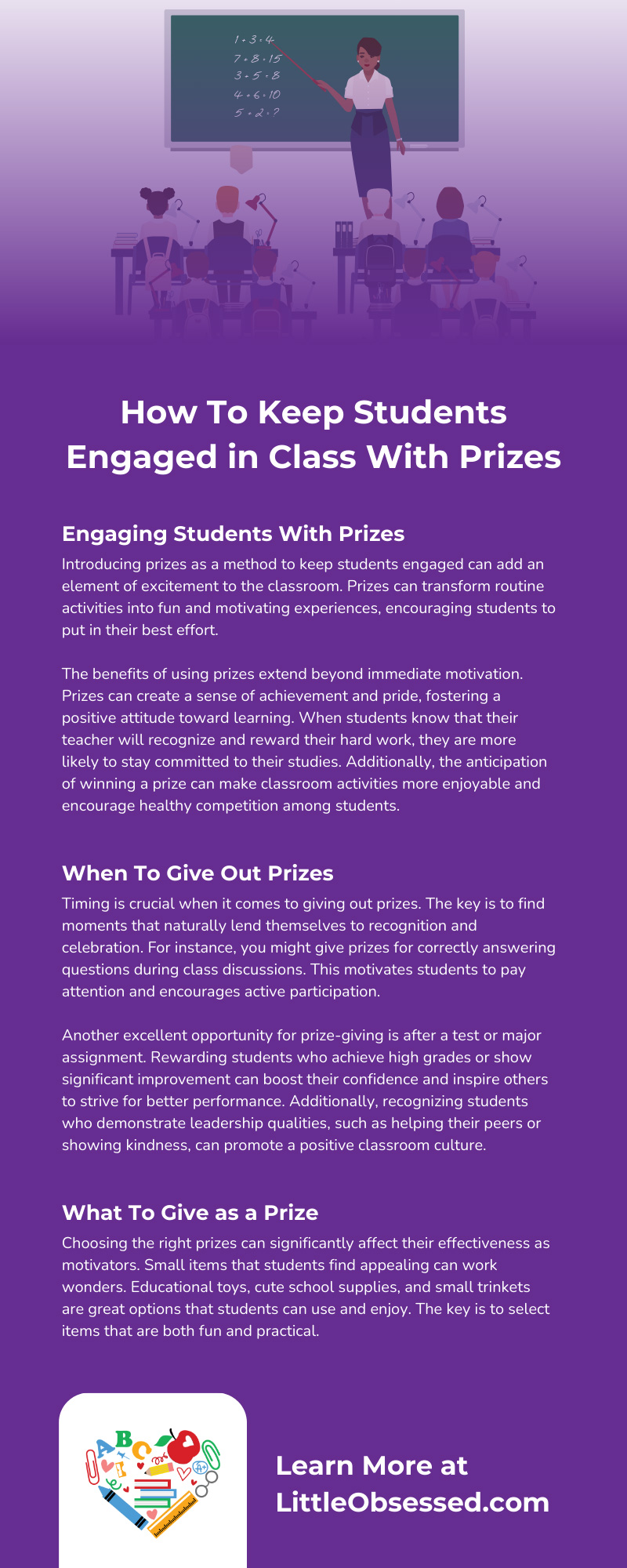How To Keep Students Engaged in Class With Prizes
17th Jul 2024

Keeping students engaged in class can sometimes be an uphill battle for teachers and educators. With distractions everywhere, maintaining students’ attention and interest is crucial for their academic success. We’ll explore how to keep students engaged in class with prizes. This is your guide to creating a thriving classroom environment.
The Importance of Keeping Students Engaged
Student engagement is essential for a productive and dynamic classroom. When students are engaged, they are more likely to participate in discussions, ask questions, and dig deeper into the subject matter. This heightened interest makes learning more enjoyable and significantly impacts their academic performance. Engaged students tend to retain information better, develop critical thinking skills, and show improved behavior. For teachers, an engaged classroom means fewer disruptions and a more focused, harmonious learning environment.
Ensuring students remain engaged throughout the school day can lead to long-term benefits. These include better grades, a stronger interest in learning, and the development of positive relationships with teachers and peers. In short, student engagement is an investment in your students’ futures, fostering a love for learning that can last a lifetime.
The Psychology of Rewards
Rewarding students isn’t a new concept, but understanding the psychology behind it can help educators use this strategy more effectively. Positive reinforcement, a concept from behavioral psychology, involves providing a reward to encourage the repetition of a desired behavior. Students are more likely to repeat these actions when they receive a prize for their achievements or good behavior.
This approach can create a positive feedback loop in the classroom. For example, if a student receives a prize for answering questions correctly, they will feel motivated to participate more actively in future lessons. Additionally, rewards can boost a student’s self-esteem and confidence, making them feel valued and recognized for their efforts. This positive reinforcement creates a supportive and motivating learning environment where students are eager to engage and succeed.
Engaging Students With Prizes
Introducing prizes as a method to keep students engaged can add an element of excitement to the classroom. Prizes can transform routine activities into fun and motivating experiences, encouraging students to put in their best effort.
The benefits of using prizes extend beyond immediate motivation. Prizes can create a sense of achievement and pride, fostering a positive attitude toward learning. When students know that their teacher will recognize and reward their hard work, they are more likely to stay committed to their studies. Additionally, the anticipation of winning a prize can make classroom activities more enjoyable and encourage healthy competition among students.
When To Give Out Prizes
Timing is crucial when it comes to giving out prizes. The key is to find moments that naturally lend themselves to recognition and celebration. For instance, you might give prizes for correctly answering questions during class discussions. This motivates students to pay attention and encourages active participation.
Another excellent opportunity for prize-giving is after a test or major assignment. Rewarding students who achieve high grades or show significant improvement can boost their confidence and inspire others to strive for better performance. Additionally, recognizing students who demonstrate leadership qualities, such as helping their peers or showing kindness, can promote a positive classroom culture.
What To Give as a Prize
Choosing the right prizes can significantly affect their effectiveness as motivators. Small items that students find appealing can work wonders. Educational toys, cute school supplies, and small trinkets are great options that students can use and enjoy. The key is to select items that are both fun and practical.
Consider incorporating items that align with students’ interests and hobbies. For example, colorful markers or sketchbooks could be perfect prizes if your students are into arts and crafts. If they enjoy reading, bookmarks or mini books might be more appealing. The goal is to choose prizes that students will appreciate and look forward to receiving.
Keep the prizes varied to maintain excitement. Rotating different types of prizes can prevent students from losing interest and keep them motivated throughout the school year.
Choosing Prizes for Different Age Groups
Selecting age-appropriate prizes is essential for maintaining students’ interest and ensuring the rewards are meaningful. For younger students, prizes like stickers, small toys, and fun erasers can be very appealing.
Consider prizes for middle school students that cater to their growing interests and independence. Items like journals, colorful pens, and small gadgets can be exciting and useful for this age group. These prizes can also encourage students to develop organizational and writing skills.
High school students may appreciate more sophisticated prizes that align with their interests and academic pursuits. Gift cards, high-quality notebooks, and tech accessories are excellent options. These prizes serve as motivation and support their academic and personal growth.
How To Keep Things Fair
Fairness is crucial when implementing a prize-giving system in the classroom. Ensuring all students have an equal opportunity to win prizes maintains a positive and inclusive environment. One way to achieve this is by establishing clear criteria for earning prizes.
Also, ensure that the prizes are of similar value and appeal. This prevents any feelings of favoritism or inequality among students. Additionally, rotating the criteria for winning prizes can give different students a chance to shine. For example, you might reward academic achievements one week, while the next week, you could focus on behavior or participation.
Keeping track of who has received prizes and when can maintain fairness. This ensures that all students have the opportunity to receive a prize.
Establish a Prize-Giving System
A well-organized prize-giving system is essential for its success. Start by setting clear rules and expectations for how and when you’ll give out prizes. Communicate these rules to your students and ensure they understand the process.
Create a schedule for prize-giving to maintain consistency. For example, you might decide to give out prizes at the end of each week or after completing a particular project. This helps students know what to expect and keeps them motivated.
Keep a record of the prizes given and the criteria used. This documentation ensures transparency and allows you to monitor the system’s effectiveness. Regularly review and adjust the system based on feedback and observations to ensure it continues to meet your students’ needs.
Understanding how to use prizes to keep students engaged will help you implement this as an effective strategy. This approach enhances students’ academic performance and fosters a positive attitude toward learning. The goal is to make learning enjoyable and rewarding, helping students develop a lifelong love for education.
For more ideas on engaging your students and creating a thriving classroom environment, check out Little Obsessed’s selection of novelty office gifts. These unique items can add a touch of fun and excitement to your prize-giving system, making every reward a memorable experience for your students.

